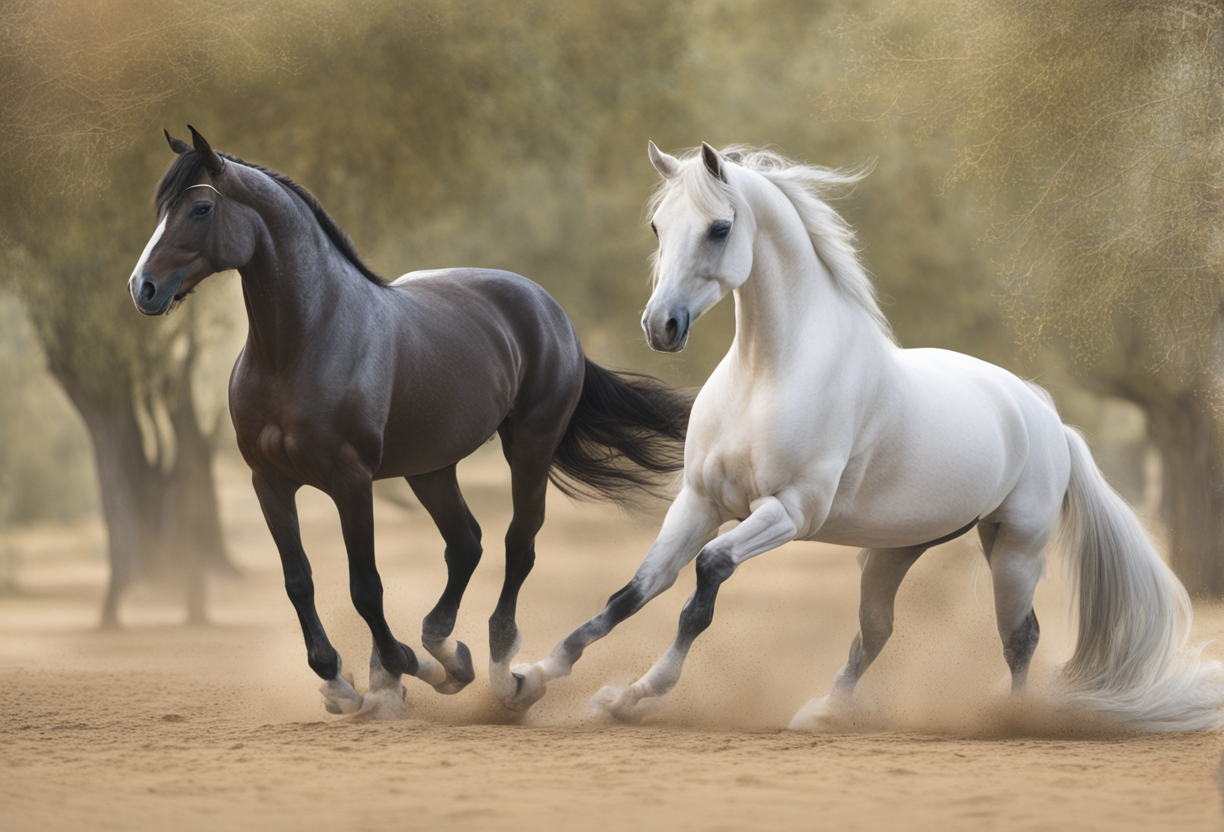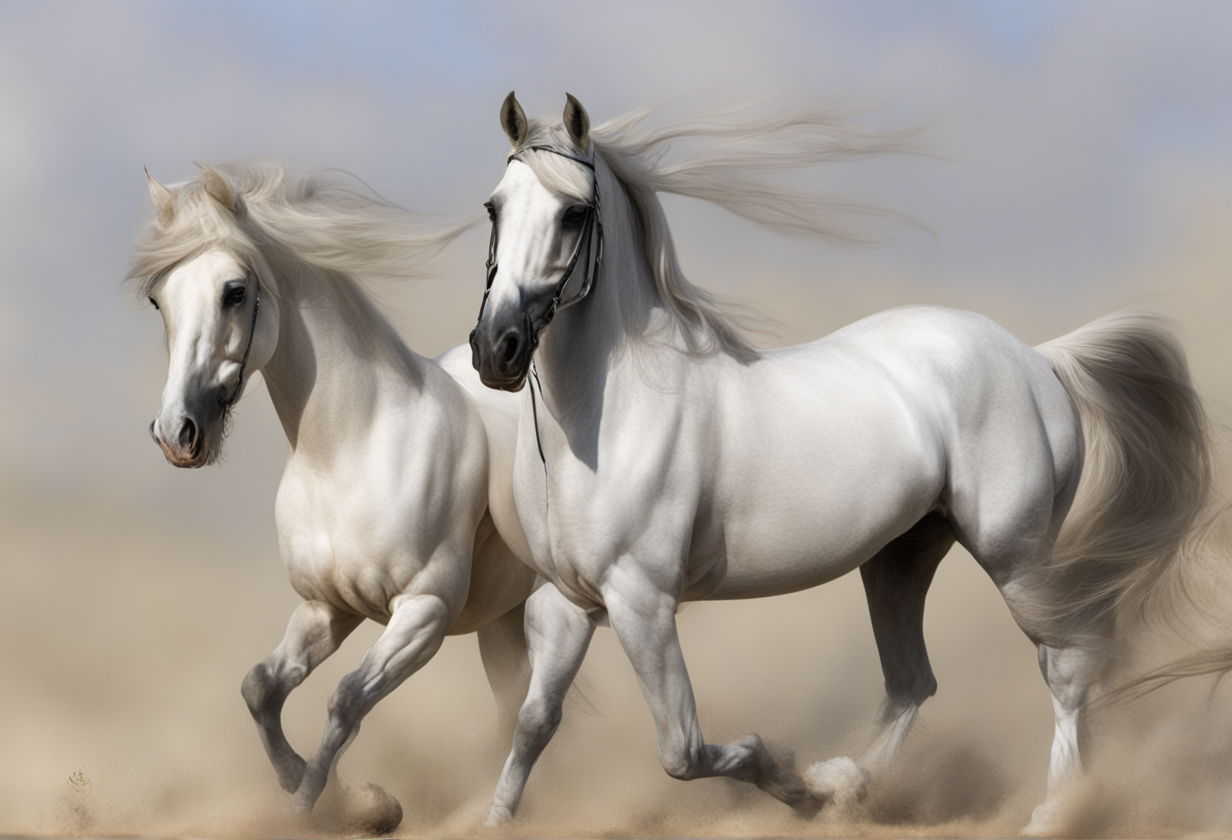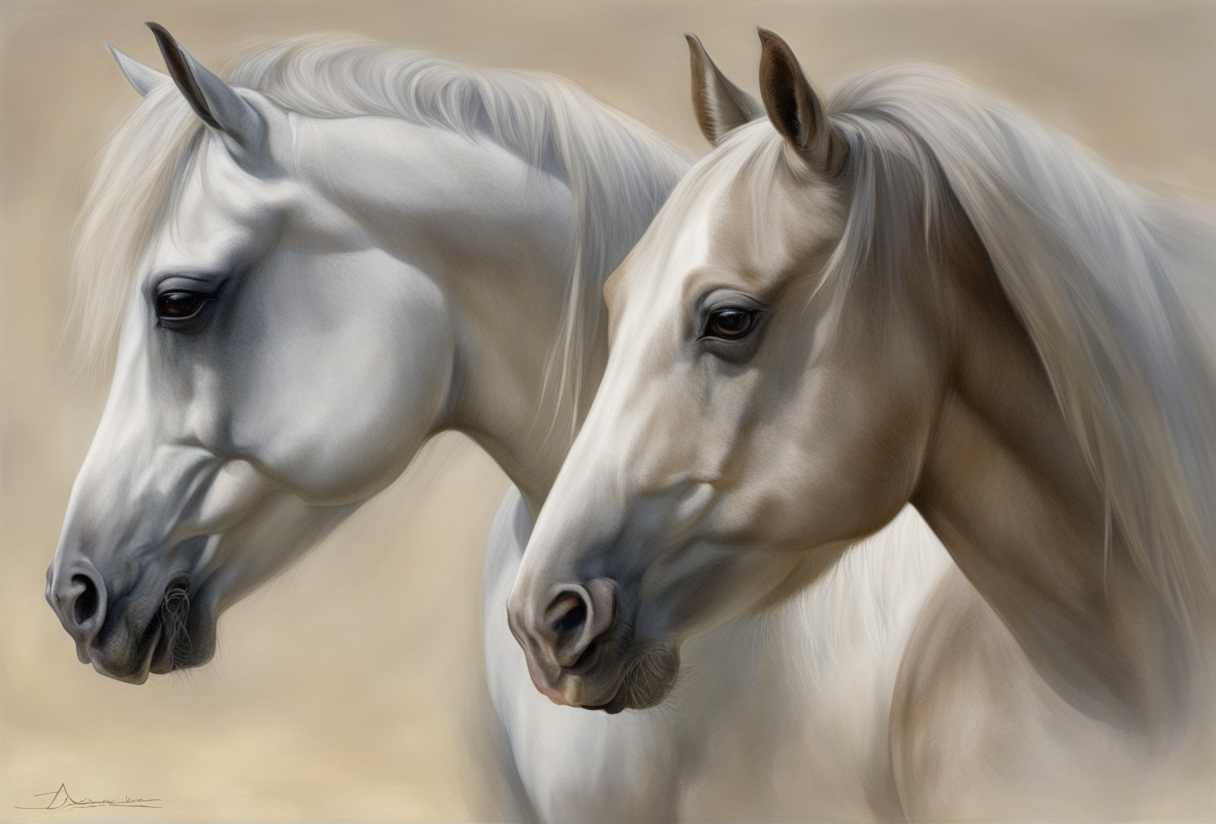As someone who’s been around horses my whole life, you’d think I’d know the difference between an Andalusian and an Arabian by now.
But it wasn’t until I went to check out some horses for sale last weekend that I really started wondering – so which is which?
And what actually separates these two beloved horse breeds?
It all started when I was cruising the classifieds looking for my next project horse when I came across ads for both Andalusians and Arabians.
Being the curious guy that I am, I decided to check them both out. First I headed to see this beautiful grey mare listed as an Andalusian.
Man, was she elegant.
Long mane and tail floating behind her as she pranced around the pasture.
I was totally swooning. Then I drove down the road to see this little pint-sized dude listed as an Arabian.
He was frisky and bold, with insane energy. I knew in that moment, there had to be some key differences between these two beauties.
So what really separates the Andalusian from the Arabian? Let me break it down for you…
Table of Contents
These Breeds’ Way Different Backstories

Turns out, these two kinds of hot bloods took totally different paths to get where they are today. Andalusians, as the name suggests, call a spot in southern Spain called Andalusia their ancestral homeland.
Experts trace their lineage back thousands of years in that region alone. Meanwhile, Arabians originated clear across the map in the Middle East – mainly around the Arabian Peninsula, which is how they earned their title.
Throughout history, Andalusians stayed primarily in Spain and Portugal, perfecting their martial and recreational skills to become renowned sport and work horses. Arabians, on the other hand, spread all the way to North Africa and Asia thanks to cultural diffusion and conquest.
Their versatility helped Arabians establish bloodlines worldwide, even making it to the Americas with the first Spanish explorers. So in summary – Andalusians, Spanish roots; Arabians, Middle Eastern lineage. That explains the very different geographical genes at play here.
You Can Totally Spot the Variance in Looks and Talents

Coming from such separate scenes has led to notable variances in physical form and function between these breeds.
Andalusians average around 15 hands high – that’s 4’3″ at the withers for all you non-horse folk. They’re muscular and strongly built for activities like dressage and bullfighting in their Spanish homeland.
On the other hand, Arabians max out shorter around 14-15 hands. Their petite frames pack hidden power thanks to compact muscle and lean conditioning. Some specimens have been clocked sprinting over 45 mph!
Another key trait is the tail set – Andalusian tails attach up higher on the back end, while Arabian tails drape lower almost reaching the hocks. Overall, Andalusians tend toward bulkier and Arabians slicier.
And let’s talk mane and tail action. Most Andalusians have thicker top-knots and whips for tails. Whereas Arabians often showcase wispier manes with finer hairs that can be braided for shows.
The variations in physique directly impact the athletics each breed naturally excels in. Where Andalusians stand out for displays of finesse like dressage and bullfighting maneuvers, Arabians steal spotlight in speed events and acrobatics.
These Breeds’ Inner Workings are a Whole Other Story

Now we’re getting into the real nitty gritty – how these types roll on the inside.
Andalusians are inclined to be more confident and level-headed – perfect for being a family-friendly partner around kids and livestock. They love to learn and think on their feet in new situations.
Arabians, in contrast, come wired to GO GO GO. Holy moly, the energy levels in these ponies! They thrive on constant mental and physical stimulation to burn off their excess sparks.
Many Arabian owners I know say riding one is like gripping a live-wire. They demand extra attention to keep them focused instead of spiraling into mischief.
Both breeds are highly intelligent, just in different ways. Andalusians specialize in solving puzzles and Arabians excel at getting their motors running. It’s all about finding a match for your personal style of riding and horsemanship.
Conformation Counts
When assessing these breeds, conformation is key to determining ideal structure.
Andalusians aim for refined heads on long necks meeting broad chests and powerful hindquarters.
Correct conformation ensures good movement and health for careers like dressage and bullfighting.
Common faults include being too leggy or lacking muscular definition important for strength and stamina.
Arabians emphasize short backs, deep hearts and slender legs for optimized speed and agility.
Ideal Arabians stand square with 17-19 ribs and sloping shoulders allowing high reaches of movement.
Weak pasterns or straight hocks pose issues as improper conformation can cause soundness problems over time.
Color Catalog
The array of coat colors displayed by these breeds is fascinating.
Andalusians come in bay, black, chestnut, gray and rare colors like dun and palomino.
Grays are a hallmark as the Silver dapple gene lightens coats beautifully with age.
Leopard complex spotting also occurs, producing dramatic Appaloosa patterns.
Arabians show solids, dapples and various spotted genetics exceptionally.
Common hues include grey, bay, chestnut, black and buckskin carrying the cream gene.
Rarest is the cream dilute “Isabelline” yielding pale gold coats and pink skin.
Bloodlines Matter
Esteemed lineages distinguish quality individuals of each breed.
Famous Andalusian strains emerge from dedicated Spanish studbooks like Domecq and Real de la Casa.
These originate famous ancestors still influencing the breed globally today.
Prominent Arabian lines trace to desert horses like the Kehilan, Seglawi and Hamdani.
Pedigrees of champions reflect prized sires preserving ideal type through generations.
Top breeding programs carefully consider conformation and ability in established bloodlines.
Well-bred horses boast refined form and manners befitting their distinguished heritage.
Hoof Care Know-How
Proper hoof maintenance is non-negotiable for these athletes.
Andalusians and Arabians both have hard hooves adapted to various surfaces.
Regular trims every 4-6 weeks by a qualified farrier keep feet in shape.
Signs like chipped hooves or contracting heels indicate need for balancing.
Corrective shoeing may be used to fix structural flaws and support tendons.
Diet also impacts hoof quality – vitamins and minerals in feed nourish hooves.
Picking feet regularly inspects for stones, abscesses or other issues arising.
Tack Talk
Different tack complements each breed’s styling and jobs.
Andalusians perform best in dressage saddles with long flaps and deep seats.
Spanish-style saddles emphasize close contact while leaving room for expression.
Araians look dashing in lighter weight, low-profile, forward-cut show saddles.
These allow high collections and make rapid maneuvers easier.
Spanish or English bridles suit Andalusians, using simple bits like snaffles.
Arabians use lighter curb or bosal bridles befitting their quick reflexes.
Favored Disciplines
Specific events highlight natural talents of each breed.
Dressage, bullfighting displays and cavalry mounts favored Andalusians.
Their balance and agility lend to tricky maneuvers and precise footwork.
Arabians rule jumping rings and race tracks with unbeatable speed and stamina.
Endurance racing plays to their efficient energy conservation over long miles.
Couture training emphasizes boldness and expression in equitation classes.
Even ranch work and recreational riding suit these willing, sure-footed partners.
Health Characteristics
Breeders work tirelessly to preserve sound heritage bloodlines.
Andalusians tend robust constitution with few inherent disease issues.
Old age well into 20s-30s isn’t uncommon with responsible lifelong care.
Arabians require extra TLC due to rare genetic disorders like SCID and PSSM.
Simple management prevents ulcers, colic and other illnesses plaguing all equines.
Routine veterinary exams screen internal organs and catch lamenesses early.
With selective matings, both thrive as healthy, long-living companion horses.
Training Techniques
Starting young horses properly sets them up for success.
Groundwork fundamentals like leading, grooming and desensitization lay the foundation.
Longeing teaches voice commands and responsiveness before saddling.
Andalusians progress steadily through classical dressage training.
Araians enjoy positive reinforcement and play-based liberty exercises.
Consistent cues and release build trust between horse and rider.
Continued education maintains well-mannered partners ready for any discipline.
Cost Comparisons
Pricing varies depending on bloodlines, training and individual quality.
Well-bred Andalusians cost $5,000-$15,000 on average for riding prospects.
Champion show horses command over $30,000 with elite bloodlines.
Arabians range $3,000-$10,000 commonly for young unstarted partners.
World-class show/endurance champions exceed $100,000 accolades considered.
Always evaluate conformation, abilities and veterinary records over name alone.
Leasing offers inexpensive trials before major investments are made.
Choosing Your Perfect Match
Different needs point riders toward ideal Andalusian or Arabian mounts.
Goals, experience, discipline and temperament must align.
Trial riding lets potential owners observe work ethic and personality.
Be honest reflecting if bombproof or spirited nature suit lifestyle more.
Fitting the horse enhances safety while fostering lifelong bonds.
With careful matching, either breed empowers wonderful riding careers.
Andalusian vs. Arabian Horse: Unraveling the Key Differences
While Andalusians and Arabians can seem awfully similar at a glance, those regional roots created some core differences worth knowing.
Andalusians lean larger and more agile for jobs like dressage with their sturdy Spanish builds. Whereas Arabians tend finer-boned and faster-paced as the classic “racehorse of the showring.”
On the inside, Andalusians run smooth and ponder while Arabians crackle and pop with thrill-seeking zeal. It boils down to if you want an elegant athlete or adrenaline junkie as your equine amigo.
I sure hope this long-winded primer has you feeling much clearer on distinguishing Andalusians from Arabians. Lemme know if any other questions come up – it’s a subject dear to my horse-lovin’ heart!
Fun Fact: Arabians were the first true breed developed from selectively breeding horses with desirable traits. The results speak for themselves in these dynamic equines.
Here is an HTML table comparing Andalusians and Arabians with 3 columns and 15 rows:
| Andalusian | Arabian | |
|---|---|---|
| Origin | Andalusia, Spain | Middle East, Arabic Peninsula |
| Average Height | 15-16 hands | 14-15 hands |
| Body Type | Muscular, strong | Lithe, refined |
| Tail Set | High | Low |
| Manes/Tails | Thick | Finer |
| Color | Bay, grey, dun | Grey, bay, buckskin |
| Temperament | Bold, calm | Energetic, alert |
| Disciplines | Dressage, bullfighting | Racing, endurance, jumping |
| Conformation | Long legs, broad chest | Short back, sloping shoulder |
| Tack | Spanish saddle, snaffle | Light saddle, curb/bosal |
| Bloodlines | Domecq, Real de la Casa | Kehilan, Seglawi, Hamdani |
| Price Range | $5,000-30,000 | $3,000-100,000 |
| Life Span | 20-30 years | 25-35 years |